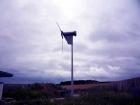Wind power generation systems can be expensive, but they can also provide great savings over time because wind is a free energy source. Under the right circumstances home wind power generation can be very cost effective. Just how cost effective a particular wind system is depends on the system’s initial cost and how much energy it produces.
Three main factors that determine the cost and productivity of a wind power system are
Wind speed in your area System type and installation method Total system cost after any incentive program rebates or tax credits The most important requirement is that you live in a windy area. It is necessary to have an average annual wind speed of at least 10 mph (4.5 m/s) in order to benefit from a wind system. The new free online application, First Look, maps global wind speeds for wind power generation potential. The United States Department of Energy publishes wind speed maps for the US on their website.
For quick reference, the 5 windiest states are North Dakota, South Dakota, Montana, Kansas, and Texas. These are followed by Nebraska, Wyoming, Oklahoma, Minnesota, Iowa, Colorado, New Mexico, Idaho, Michigan, New York, Illinois, California, Wisconsin, Maine, and Missouri. In other parts of the world, the windiest places tend to be over the mid continental planes. If you live in any of these places, chances are wind power is economically viable for you.
The type of wind turbine you choose and how it is installed are also important factors. The two main types of turbines are horizontal axis wind turbines and vertical axis wind turbines. There are advantages and disadvantages of each, and your site will likely determine which the best economical choice is. If you are able to put your turbine up on a tall tower to receive the strongest and least turbulent wind possible, then a horizontal axis is probably your better option. Vertical axis wind turbines are difficult to install on towers and are better suited for roof or ground installation. The disadvantages of this type of installation are that wind quality is poorer so there is more wear and tear on the turbine and less power output. Though rooftop turbines don’t produce as much power as tower mounted turbines, they are much less expensive because the tower is one of the most expensive system components.
Finally, the total cost of your system influences your payback. You will recoup your expenses more quickly if you minimize the initial cost of your system. There are many renewable energy incentive programs and tax credits to help you pay for your wind power system. As of 2009 there is a new federal tax credit for wind, solar and other renewable energy systems that will pay for 30% of the total system cost.?
Many states including California, New York, and others have additional incentive programs for small wind systems. The Database of State Incentives for Renewables and Efficiency (DSIRE) is a comprehensive and easily searchable database of state renewable energy incentive programs.
